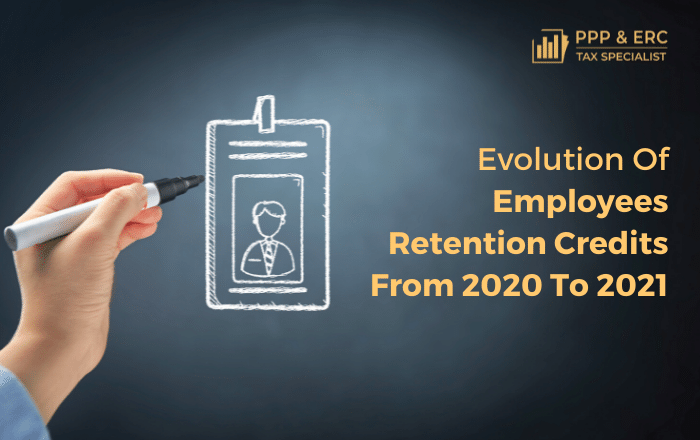
EMPLOYEE RETENTION CREDIT STRENGTHENED AND EXTENDED FOR MORE ECONOMIC RELIEF TO BUSINESSES
To provide financial relief to businesses struggling due to the Covid-19 government restrictions, the US government came up with the Coronavirus Aid, Relief, and Economic Security Act (CARES Act). This comprehensive act established programs that supported employers in keeping their employees on the payroll despite the economic slump. Under this act, the Employee Retention Credit (ERC Credit) was formulated to provide a refundable tax credit to employers per employee on a quarterly or annual basis. Prior to this, the Paycheck Protection Program (PPP) received a lot of attention and a plethora of businesses applied for PPP loans. However, the CARES Act established this tax credit to keep employees from losing their jobs.
Can employers apply for both Employee Retention Credit and PPP?
The ERC is easier to obtain than a PPP loan. It may or may not be better than PPP for some employers but it lasts till the end of December 2021. Contrastingly, the PPP loan program expired on May 31. When it was brought into action, an organization or company could not apply for both Employee retention tax credit as well as PPP. Due to this, many organizations didn’t go for the refundable tax credit. But the Congress altered this rule and now an employer can obtain and ERC along with a PPP loan retroactively back to 2020. However, PPP loan support cannot be used in calculation of employee retention credit amount.
What is the difference between the Employee Retention Credit and PPP?
There are significant differences between how the PPP and the ERC define certain terms. Payroll costs are identified differently for both the programs. Another important feature is that full-time equivalents are also not defined as the same. The legalities around affiliation and aggregation are distinct too. For the ERC, it is vital to note that members of a controlled group are considered as a single employer and need to be aggregated when admitting the eligibility for receiving the credit. They also consider if employers meet the government lockdown rules when looking at revenue reductions and headcount.
What are criteria of a Full Time Employee as per ERC?
An employee who works at least 30 hours per week or 130 hours in a month is defined as a full-time employee.
How to apply for the (ERC Credit) Employee Retention Tax Credit?
To receive financial aid in the form of tax credit under ERC, employers need to talk to their tax consultants and find out if they are eligible. Next, they should file for updated Form 941s with the help of their tax accountants for the applicable 2020 quarter. For 2021, eligible employers can compute the estimated ERC for the period and reduce their payroll tax deposits by the amount they can rationally estimate.
Moreover, employers can apply for an advance through Form 7200. Amounts will be adjusted with their corresponding quarterly 941 filings. They can claim any refund or roll it forward. It is really important that employers maintain impeccable records to support eligibility, calculations and claims.
Documentation of everything is the number one priority for claimants of PPP loans and ERC. They should maintain clear records of eligibility support, certifications, covered payroll and non-payroll costs for PPP forgiveness. They should also not miss out on analysis of payroll costs applied for PPP forgiveness and the ERTC.
All small businesses and employers that fall within the eligibility criteria should consult their tax professionals and work out how best they can claim the benefits applicable to them. They should try to optimize the benefits offered under these programs. Since the amendments by the US government, business owners should utilize the option to club PPP & ERC.
How can employers claim the ERC (Employee Retention Credit)?
Thankfully, the ERC has been devised in a manner that makes it easy for employers to claim it. In stark contrast to the PPP, this tax credit does not require employers to approach a bank and wait for it to be approved and funded. To claim tax credit under the ERC, employers simply need to reduce the amount of their share of payroll taxes on employee wages. Usually, an employer has to pay these taxes on a quarterly basis. This reduction needs to be considered in employment tax return the employer files on a quarterly basis, usually IRS Form 941, Employer's Quarterly Federal Tax Return.
The ERC was previously unavailable as an option for relief to businesses that received Paycheck Protection Program (PPP) loans through the SBA. However, the new legislation explicitly provides a retroactive amendment to March 27,2020 and clarifies these businesses are eligible to receive the ERC—just not on wages paid with PPP loan funds. Other important changes to the ERC include: (1) a prospective credit increase from 50% of up to $10,000 of qualified wages annually to 70% $10,000 of qualified wages per quarter starting January 1, 2021; and (2) public universities and hospitals are now considered eligible employers.
Conclusion:
Coronavirus Aid, Relief, and Economic Security Act (CARES Act) extended the reach of the Employee Retention Credit (ERC) with easier claims and more benefits for businesses. However, the implications of the Paycheck Protection Program (PPP) are different and make it complex. Businesses meeting eligibility criteria can gain much with this evolution of ERC.
Retroactive amendments and intertwined rules with PPP make ERC complex. All you need is experienced specialists in ERC & PPP to get the maximum out of this opportunity.
Book a 15 min no obligatory call with Jason to speak on how the ERC & PPP specialist team of Jason Dinesen, EA, LPA can help you. With years of experience in their bucket, you have a higher chance of getting on the winning side.